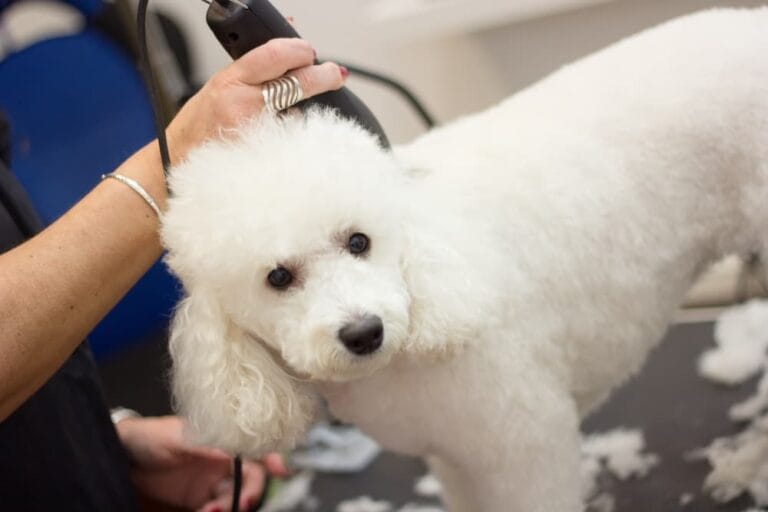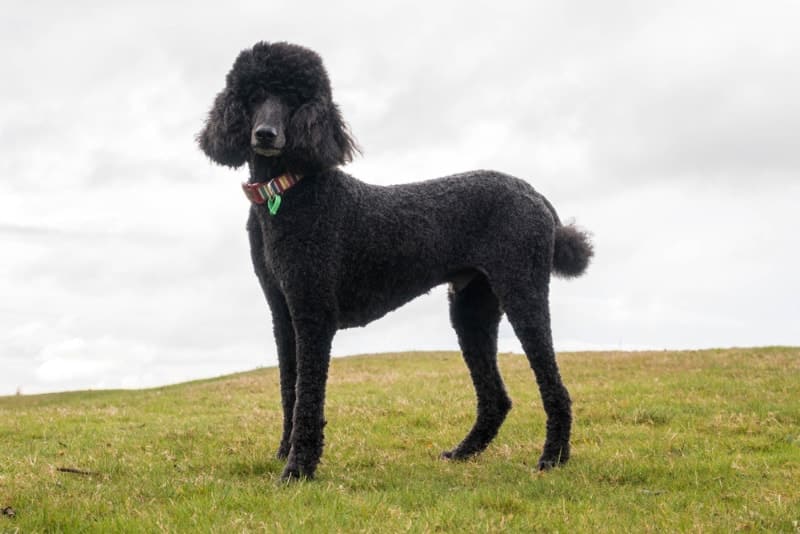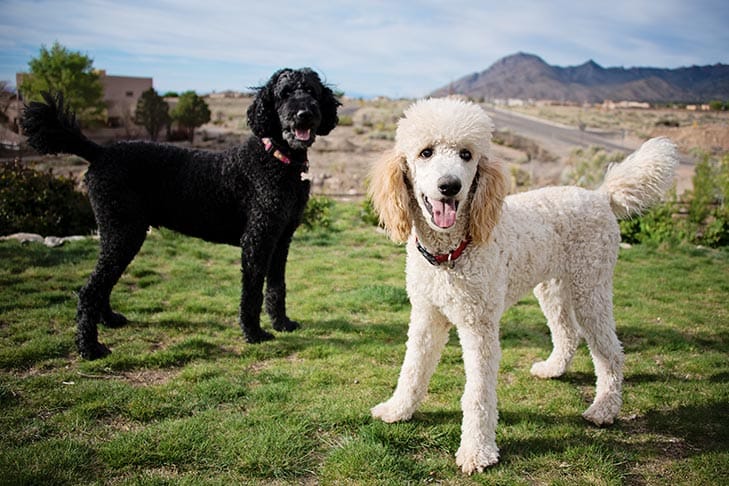Giant poodles, also known as royal poodles, are a larger version of the standard poodle breed. These dogs are known for their elegant appearance and friendly personalities. They have become increasingly popular among dog lovers in recent years due to their unique size and temperament.
Giant poodles are known for their intelligence and trainability, making them excellent family pets. They are also hypoallergenic, making them a great choice for people with allergies. Despite their large size, they are gentle and affectionate, making them great with children and other pets.
While giant poodles may require more space and exercise than their smaller counterparts, they are still relatively low-maintenance dogs. Their curly coats require regular grooming to prevent matting, but they do not shed much. Overall, giant poodles are a great choice for anyone looking for a loyal and loving companion with a unique look.
Breed Overview
History
Giant Poodles, also known as Standard Poodles, have a rich history that dates back to the 15th century. Originally bred in Germany as water retrievers, they were used to hunt waterfowl. The breed was later popularized in France, where they became a favorite of the aristocracy. Today, the Giant Poodle is recognized as one of the most intelligent dog breeds and is used for various purposes, including as a service dog, a therapy dog, and a family pet.
Characteristics
Giant Poodles are known for their intelligence, loyalty, and trainability. They are highly social dogs and enjoy spending time with their owners. They are also known for their hypoallergenic coat, which makes them a popular choice for people with allergies. Giant Poodles are generally friendly with strangers, but they can be protective of their family. They require regular exercise and mental stimulation to keep them happy and healthy.

Size and Appearance
Giant Poodles are a large breed, standing at 18 to 24 inches tall at the shoulder and weighing between 45 and 70 pounds. They have a distinctive curly coat that comes in a variety of colors, including black, white, brown, and apricot. Their coat requires regular grooming to prevent matting and tangling. Giant Poodles have a long, elegant neck, a straight back, and a square-shaped body. They have a proud, regal appearance that is accentuated by their high-set, long ears and dark, intelligent eyes.
In conclusion, the Giant Poodle is a versatile and intelligent breed that makes an excellent companion for families and individuals alike. With their hypoallergenic coat, friendly demeanor, and trainability, they are a popular choice for people with allergies and those looking for a loyal and affectionate pet.
Care and Maintenance
Grooming Needs
Giant poodles have a thick, curly coat that requires regular grooming to prevent matting and tangling. They should be brushed at least once a week with a slicker brush and metal comb to remove loose hair and prevent matting. It's also important to trim their hair every 6-8 weeks to maintain their coat's shape and prevent it from becoming too long and tangled.
In addition to regular brushing and trimming, giant poodles should also have their ears cleaned regularly to prevent infections. This can be done using a damp cloth or cotton ball and a gentle ear cleaner recommended by a veterinarian.

Exercise Requirements
Giant poodles are energetic dogs that require regular exercise to stay healthy and happy. They should be taken for a daily walk or run to help burn off excess energy and prevent boredom. In addition to daily walks, they also enjoy playing fetch, swimming, and participating in agility training.
It's important to note that giant poodles are prone to joint problems, so it's important to avoid excessive jumping and running on hard surfaces. Additionally, they should not be exercised in extreme temperatures, as they are sensitive to heat and cold.
Diet and Nutrition
Giant poodles require a balanced diet that provides them with the nutrients they need to stay healthy. They should be fed a high-quality dog food that is appropriate for their age, weight, and activity level. It's important to avoid overfeeding, as giant poodles are prone to obesity.
In addition to a balanced diet, giant poodles should also have access to fresh water at all times. It's important to monitor their water intake, as they are prone to urinary tract problems. If you notice any changes in their drinking habits or behavior, it's important to consult with a veterinarian.
Health and Lifespan
Common Health Issues
Like all dog breeds, Giant Poodles are prone to certain health problems. Some common health issues that Giant Poodles may face include hip dysplasia, eye problems, and skin allergies. Hip dysplasia is a condition where the hip joint doesn't fit properly, which can cause arthritis and lameness. Eye problems can include cataracts, progressive retinal atrophy, and glaucoma. Skin allergies can cause itching, redness, and hair loss.
Life Expectancy
Giant Poodles have a lifespan of around 10 to 12 years. However, with proper care and attention, some Giant Poodles have been known to live up to 15 years or more. It's important to keep your Giant Poodle healthy by providing a balanced diet, regular exercise, and routine veterinary check-ups. Early detection and treatment of any health issues can also help to prolong your Giant Poodle's lifespan.
Overall, Giant Poodles are generally healthy dogs with a long lifespan. However, it's important to be aware of the potential health issues that they may face and to take steps to prevent and treat them. By providing your Giant Poodle with the care and attention that they need, you can help to ensure that they live a long and happy life.

Training and Behavior
Training Techniques
Training a giant poodle requires patience, consistency, and positive reinforcement. These dogs are highly intelligent and eager to please, making them quick learners. However, they can also be stubborn at times, so it's important to establish yourself as the pack leader early on.
One effective training technique for giant poodles is clicker training. This method uses a clicker to mark desired behavior and reward the dog with treats. It's a gentle and effective way to teach new commands and behaviors.
Another important aspect of training a giant poodle is socialization. These dogs can be wary of strangers and other animals if not properly socialized from a young age. Exposing them to a variety of people, animals, and environments can help them become well-adjusted and confident adults.
Behavioral Traits
Giant poodles are known for their friendly and affectionate nature. They thrive on human companionship and make excellent family pets. However, they can also be high-strung and require plenty of exercise and mental stimulation to prevent destructive behavior.
These dogs are also prone to separation anxiety, so it's important to gradually acclimate them to being alone for short periods of time. Crate training can be helpful for this, as it provides a safe and secure space for the dog when you're not home.
Overall, with proper training and socialization, giant poodles can be well-behaved and loving companions. It's important to be patient and consistent in your training efforts, and to provide plenty of exercise and mental stimulation to keep them happy and healthy.
Giant Poodle as Pets
Suitability for Families
Giant Poodles are known for their friendly and affectionate nature, making them great family pets. They are intelligent, trainable, and love to please their owners. However, due to their large size, they may not be suitable for families with small children or elderly members who may be knocked over accidentally. It is important to supervise interactions between children and Giant Poodles to prevent any accidents.
Living Conditions
Giant Poodles are adaptable dogs and can live in a variety of living conditions. They are comfortable in apartments as long as they receive enough exercise and mental stimulation. However, they do require regular exercise and a yard to play in would be ideal. They are also sensitive to extreme temperatures and should not be left outside for extended periods of time in hot or cold weather.
In summary, Giant Poodles can make great family pets as long as they are trained and socialized properly. They are adaptable to different living conditions but do require regular exercise and mental stimulation. It is important to supervise interactions between children and Giant Poodles to prevent any accidents.
Breeding and Genetics
Genetic Diversity
Giant Poodles are a relatively new breed, having been developed in the 20th century by breeding Standard Poodles with larger breeds such as the Great Dane and the Irish Wolfhound. As a result, the genetic diversity of the breed is currently quite limited. This can lead to health problems and other issues, such as a predisposition to certain genetic disorders.
To combat this, responsible breeders are working to increase genetic diversity by introducing new bloodlines into their breeding programs. This can help to reduce the risk of inherited health problems and ensure the long-term health of the breed.

Breeding Standards
Breeding Giant Poodles requires a thorough understanding of genetics and a commitment to responsible breeding practices. Breeders must carefully select breeding pairs based on a variety of factors, including temperament, health, and conformation to breed standards.
The American Kennel Club (AKC) sets the breed standard for Giant Poodles, which includes guidelines for physical characteristics such as size, coat type, and color. Breeders must adhere to these standards in order to produce healthy, well-adjusted puppies that meet the expectations of potential owners.
In addition, responsible breeders will conduct genetic testing on their breeding dogs to ensure that they are not carriers of any genetic disorders that could be passed on to their offspring. This helps to reduce the risk of inherited health problems and ensures that the puppies are as healthy as possible.
Overall, breeding and genetics are critical components of the Giant Poodle's development and long-term health. By carefully selecting breeding pairs and working to increase genetic diversity, responsible breeders can help to ensure the continued success of this unique and beloved breed.
Giant Poodle Activities
Competitions
Giant Poodles are known for their intelligence, agility, and trainability, making them excellent contenders in various dog competitions. They excel in obedience, agility, and conformation shows. In obedience competitions, they showcase their ability to follow commands and perform tasks with precision. In agility competitions, they demonstrate their speed, coordination, and problem-solving skills. In conformation shows, they are judged based on their physical attributes and adherence to breed standards.
Work and Service
Giant Poodles are versatile dogs that can be trained for various types of work and service. They make excellent therapy dogs due to their gentle and affectionate nature. They can also be trained as assistance dogs for people with disabilities, such as guide dogs for the blind or hearing dogs for the deaf. Their intelligence and trainability make them suitable for search and rescue operations, as well as law enforcement work. Additionally, they can be trained for herding and hunting activities.
Overall, Giant Poodles are a breed that is highly trainable and adaptable to various activities and tasks. They thrive in environments where they can engage their minds and bodies, and they excel in competitions and service work.
Adoption and Purchase

Finding a Breeder
When looking for a Giant Poodle breeder, it is important to do your research and find a reputable one. A good breeder will have a clean and healthy environment for their dogs, provide proper socialization, and be knowledgeable about the breed. They should also be willing to answer any questions you have and provide health clearances for their dogs.
One way to find a breeder is through the AKC Marketplace or by contacting the Poodle Club of America. You can also attend dog shows to meet breeders and see their dogs in person. Make sure to ask for references and do your own research before making a purchase.
Adoption Options
Adopting a Giant Poodle can be a great option for those who want to give a dog a second chance. Many rescue organizations and shelters have Poodles available for adoption. It is important to note that rescue dogs may come with some behavioral or health issues, so it is important to do your research and be prepared to provide the necessary care and training.
Some organizations that specialize in Poodle rescue include the Poodle Club of America Rescue Foundation and the National Poodle Rescue. Adopting a dog can be a rewarding experience, and it is important to give these dogs a loving home.
Whether you choose to adopt or purchase a Giant Poodle, make sure to do your research and find a reputable source. With proper care and training, these dogs can make wonderful companions.
Legal and Ethical Considerations
Giant Poodles are a popular breed of dog, but owning one comes with certain legal and ethical considerations. In some areas, there may be laws or regulations that restrict ownership of certain breeds, including Giant Poodles. It is important for potential owners to research and understand these laws before bringing a Giant Poodle into their home.
Additionally, Giant Poodles require a significant amount of time, attention, and resources to properly care for. It is important for owners to provide their Giant Poodle with proper nutrition, exercise, and medical care. Neglecting these responsibilities can result in legal action and ethical concerns.
Owners should also consider the potential impact of owning a Giant Poodle on their community and environment. Giant Poodles are large dogs that require space and exercise, which may not be suitable for all living situations. It is important for owners to be respectful of their neighbors and surroundings, and to properly train and socialize their Giant Poodle to prevent any negative interactions.
Overall, owning a Giant Poodle can be a rewarding experience, but it is important for potential owners to consider the legal and ethical implications before making a commitment. By understanding and fulfilling their responsibilities as owners, they can provide a safe and happy home for their Giant Poodle while also being respectful members of their community.
Conclusion:
In conclusion, Giant Poodles are remarkable for their intelligence, versatility, and elegance, making them exceptional companions for various lifestyles. As larger versions of the standard Poodle, they require mindful care including regular grooming, sufficient exercise, and a balanced diet to maintain their health and well-being. Potential owners should commit to responsible ownership, considering their space and the dog's exercise needs. By providing the necessary care and ensuring proper socialization and training, Giant Poodles can be loving and loyal additions to any family, thriving in environments that match their energetic and affectionate nature.




